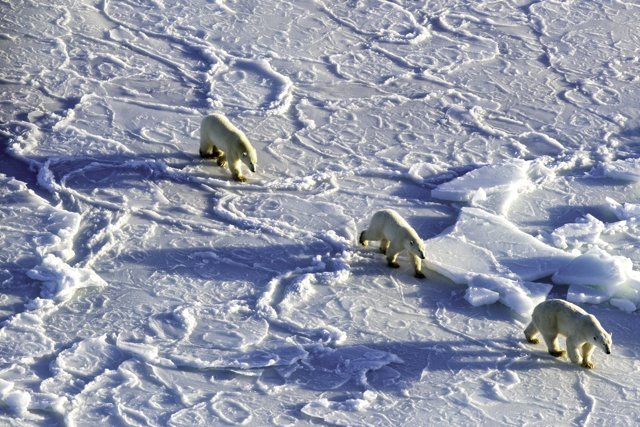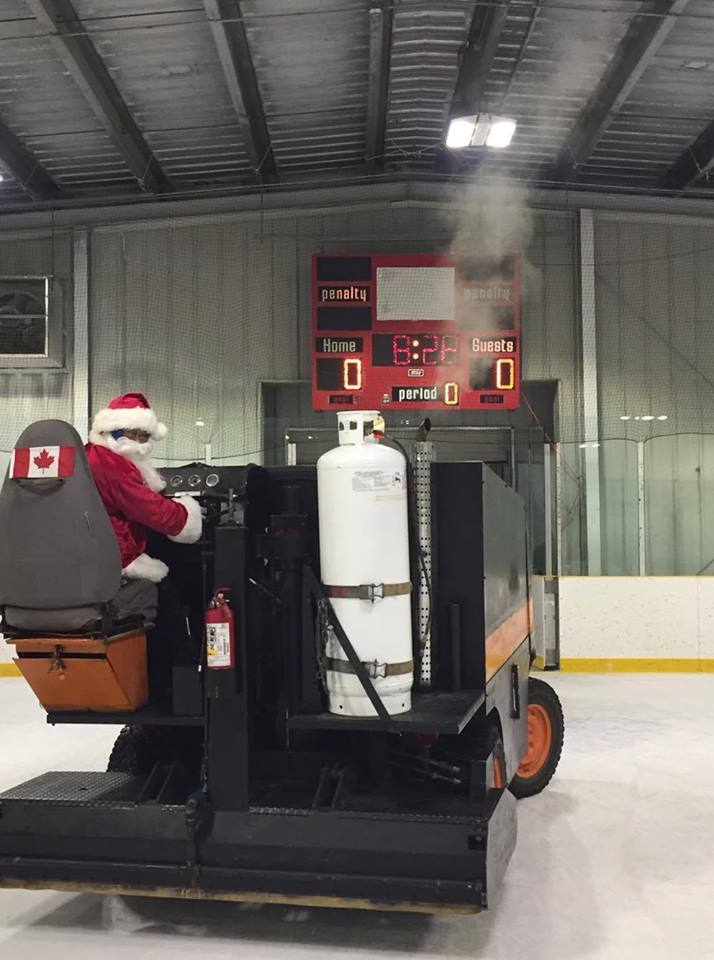by Steve Selden | Apr 25, 2018 | Conservation

Polar bear sow and two 2-year-old cubs. Brad Josephs photo.
Despite frequent heart-wrenching images of starving polar bears in the news recently, populations of polar bears are apparently thriving in the Nunatsiavut region of northern Labrador. This is some welcome good news on the status of polar bears in the Arctic.
Based on a quota of 12 polar bears from licenses granted this year by the Nunatsiavut government, wildlife manager Jim Goudie reported that the Inuit quota was filled within the initial seven days of the season.
“There are lots of signs of bears,” he told CBC Radio’s Labrador Morning. “Lots of bears and a continuation of what we’ve seen over the last three or four years.”
According to Goudie, a 2007 survey showed there were around 880 polar bears in the northern Quebec and Labrador regions while the revised numbers recorded show 2,152. This increase is a dramatic rise in the population. Researchers are involved in a two – year study that is indicating even more positive numbers.
“You can go wherever you want to within Nunatsiavut or the Labrador Inuit settlement area to harvest your polar bear,” he said. “Anywhere outside of Nunatsiavut boundaries, the harvest would be illegal.”
To keep track of polar bear pelts that are often sold to wealthy suitors from Asia to Canada, the furs are embedded with a computer chip validating when and where it was taken as well as proof it was acquired through a legal hunt and not poached. Any meat that is not used by the hunters must be donated.
“I think our polar bear population is very, very healthy,” he said. “The Davis Strait polar bear population is probably one of the most healthy in Canada, and certainly in the world.”
With regards to other populations in general, Goudie says most are in good standing and only a few are declining. Still, the fear propaganda is in the news and can be misleading.
Goudie highlights a National Geographic post showing it first look a starving polar bear, but in reality, the polar bear was sick and not long for life.
“It’s an easy story to put out there, that polar bears are in massive trouble. Sometimes I have to bite my tongue or keep my fingers off the keyboard when I see those social media posts,” he said.
Hopes are high that all polar bear populations in the Arctic will continue to thrive and adapt to a warmer climate in the coming years.
by Steve Selden | Apr 8, 2018 | Churchill Photography

Buffalo on the road to Fort Chipewyan,Alberta. Don Voyageur photo.

Beautiful sunrise Norman Wells, NWT Reza Behboudi photo.
Two beautiful shots from Canada’s north. The light and surprises are never ending in the breath – taking Arctic ad sub – Arctic. Enjoy!
by Steve Selden | Mar 8, 2018 | Churchill News
When one thinks Arctic landscape, one usually visualizes serene endless tundra or boreal forest with snow covered trees! There’s a section of that austere boreal forest in Inuvik that has five dormant satellite receivers that look alien to the habitat and have been ready for use since 2016.
The satellite receivers were built by Norway’s Kongsberg Satellite Services and American satellite company Planet Lab. Over 18 months ago the application process for federal licensing commenced and since has been caught up in government red tape. The anticipated turnaround was six months.
Going into the application process, both companies expected a turnaround of about 180 days. Word surfaced last week that the licenses were finally approved though no formal announcement has been made. Global Affairs Canada, needs to approve an auxiliary license under Canada’s Remote Sensing Space Systems Act. Until this happens the dishes cannot be activated. Since these installations are integral to a remote sensing space system they need approval from the two agencies.

Inoperable Invuk Satellite receivers constructed two years ago are unused due to one federal license still needing approval. Rolf Skatteboe photo.
“I’ve got the message … hey you’ve gotten the approvals now you can get started, which unfortunately isn’t true,” he said.
Global Affairs Canada apparently has cleared the department to “proceed in evaluating our application” according to Skatteboe.
“We still don’t know … when we will potentially get a license or not,” Skatteboe said. “That’s the most frustrating part.”
Planet Lab and Kongsberg have spent millions to build the installations at Inuvik Skatteboe values the single large antenna installation at around $6 million, and four of the smaller Planet Lab installations at roughly $8 million. The sixth antenna has received the licensing it needs since its use under the Remote Sensing Space Systems Act did not require review.
Kongsberg constructed its satellite installations in Inuvik prior to being issued a license since the building season in the North is so short and doesn’t allow for flexibility. The company didn’t anticipate delays of the magnitude that has occurred.
Skatteboe added Kongsberg contracted with the European Space Agency to utilize the Inuvik ground station in conjunction with the European Space Agency (ESA) environmental Earth monitoring project named the Copernicus program.

A Kongsberg Satellite Services satellite station in Svalbard, Norway is one of 21 stations around the world and had very little resistance for permitting unlike what he has encountered in Canada according to company president and CEO Rolf Skatteboe. Rolf Skatteboe photo.
“[Kongsberg Satellite] has 21 ground stations around the world and they have all been licensed without any problems,” he said.
“So [Kongsberg] did not expect any problems related to approval to receive … data from an ESA satellite, an organization where Canada also is an associated member.”
“[Kongsberg Satellite] applied more than a year before the system was planned to be operational,” said Skatteboe.
The uncertainty surrounding when, or if, Kongsberg’s installations will ever be approved for use is the main concern.
“If Canada decided what we’re doing is a threat to national security, fine, I accept that,” he said.
“The frustrating part is that we haven’t gotten any feedback on the timescale for them to rule on this one.”
Global Affairs Canada, department spokesperson Brittany Venhola-Fletcher said in an email statement that, “Global Affairs Canada continues to work closely” with Kongsberg and Planet Labs to finalize and hopefully approve their licensing application.
by Steve Selden | Dec 19, 2017 | Churchill Photography

Santa picking up a little extra work in Arviat. Robert Gibbons photo.
Hockey trumps all in Canada and way up north in Arviat everyone pitches in….even Santa Clause! Hopefully, his sleigh moves a little faster than this machine. Wishing everyone a joyous Christmas and Chanukah!
by Steve Selden | Nov 17, 2017 | Churchill News
With little time to waste a new player has surfaced in the crucial sale of the Port of Churchill to two independent First Nations groups in the north. Investment firm Fairfax Financial Holdings from Toronto hopes to partner with One North and Missinippi Rail LP to wrest ownership from Denver, Colorado-based Omnitrax and set forth in motion the extensive repairs to the Hudson Bay Line damaged by severe flooding last May.

The Port of Churchill may be under new ownership soon. CBC News photo.
The new prospective partner will also bring a financially sound backing and a strong business base to the deal that Churchill officials and residents hope will secure access to the south and free them from isolation.
According to reliable sources, a negotiator for the federal government, former clerk of the Privy Council Wayne Wouters, has brokered a deal with the two potential owners.
“This development has the potential to contribute to an arrangement supported by First Nations and communities in northern Manitoba,” Natural Resources Minister Jim Carr said in a statement released Thursday.
“This would enable a sustainable business approach that results in a safe and reliable rail line.”
Paul Rivett, president of Fairfax Financial Holdings, said “we are optimistic about the prospects of northern gateways.” stated in a press release.
“The Churchill rail corridor and the Port of Churchill are important pieces of infrastructure for northern communities and to the economy of Canada. Partnering with First Nations and communities is the right model for this investment,” Rivett said.
He said Fairfax will rely on a company it has invested in, AGT Foods, to develop a plan that is “viable and profitable in the long term as a business.”
Earlier this week, Ottawa responded with an $18-million lawsuit against Omnitrax after it filed filed a claim for damages against the federal government under the rules of the North American Free Trade Agreement.
The head of the Fairfax, V. Prem Watsa, has been characterized as the “Warren Buffet of Canada” often investing in troubled companies and turning them into a positive entity. Watsa invested in BlackBerry and Fairfax has significant holdings in several other companies.

Fairfax Financial CEO and chair V. Prem Watsa.CBC News photo.
Omnitrax signed a memorandum of understanding with First Nations Consortium Missinippi Rail in June and then joined forces with One North to strengthen interests in purchasing Omnitrax’s Manitoba assets.
Churchill Mayor Mike Spence, in a written statement to CBC News, said transferring the port and rail line to a stable, strong northern regional ownership group is the highest priority. He is behind the efforts to find a partner to purchase the assets one hundred per cent.
“I am pleased that there are outstanding companies that also share this vision. We now need the negotiations expedited and [to] ensure our preparations for repairs to the rail line and port are ready for the 2018 season,” wrote Spence.









